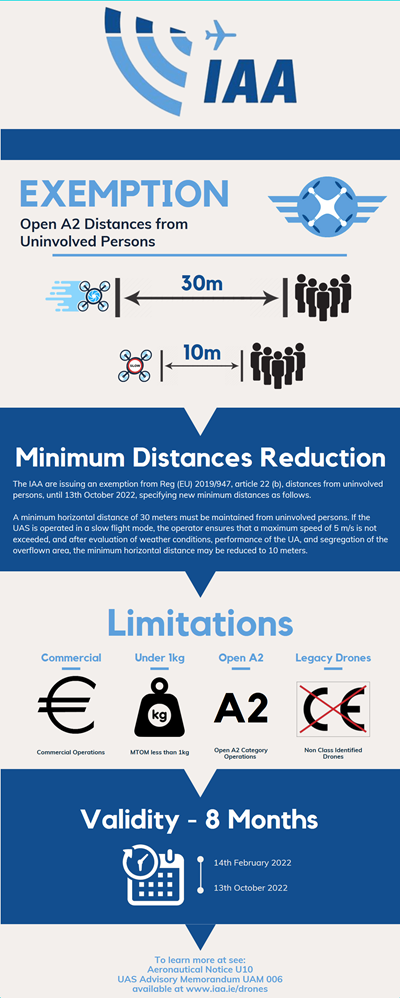Art 71(1) Exemption - UAS
To help facilitate the drone industry, the IAA have published an exemption to the distances from uninvolved persons for UAS Open A2 operations.
Situation
Regulation (EU) 2019/947, Annex, UAS.OPEN.030 paragraph (1) requires operations in the open category, subcategory A2 to be conducted at least 30 metres from uninvolved persons, which may be reduced to a minimum of 5 metres when operating an Unmanned Aircraft (UA) with an active low speed mode function and after evaluation of weather conditions, performance of the unmanned aircraft, and segregation of the overflown area.
However, paragraph (3) requires the operation to be performed with a class C2 marked UA, complying with the requirements of Regulation (EU) 2019/945 Annex Part 3, and operated with active and updated direct remote identification system and
geo-awareness function.
Alternatively, Regulation (EU) 2019/947, Article 22 – Transitional provisions, paragraph (b) permits UAS operations in the open category, subcategory A2 for UA with a take-off mass of less than 2kg, which do not comply with the requirements of Part 3 of the Annex to Commission Delegated Regulation (EU) 2019/945 by keeping a minimum horizontal distance of 50 meters from people. This is valid for the duration of the transitional period only.
Post the transitional period, under Regulation (EU) 2019/947, art 20, legacy drones, (i.e. UAS which do not comply with Delegated Regulation (EU) 2019/945, which are not privately-built and are placed on the market before 1 January 2023) will be classified as open category, subcategory A3, unless they have a maximum take-off mass of less than 250 g.
Problem
Regulation (EU) 2019/947, Article 22 takes no account of currently available slow flight modes to reduce the minimum distance to uninvolved persons. These restrictions at best severely limit the use of UAS in urban areas, and frequently make the operations in the open category impossible.
Until the 01st January 2022, existing national regulations were able to mitigate this.
Exemption
A minimum horizontal distance of 30 meters must be maintained from uninvolved persons.
If the UAS is operated in a slow flight mode, the operator ensures that a maximum speed of 5 m/s is not exceeded, and after evaluation of weather conditions, performance of the unmanned aircraft, and segregation of the overflown area, the minimum horizontal distance may be reduced to 10 meters.
Mitigations
The exemption will also be limited to UA with a MTOM of less that 1kg to limit the kinetic impact.
The amended distances from uninvolved persons correspond to those of the open category, sub-category A2, with an increase to reduced slow speed distance to 10m to account for the more common 5m/s slow speed mode currently.
Although existing slow flight modes are not classified in the sense of Delegated Regulation (EU) 2019/945, they are similar in their mode of operation. Thus, with a limitation to 5 m/s and a reduced distance of 10m, there is a sufficient level of safety until Class C2 marked UA are introduced to the European market.
For more info, visit www.iaa.ie/drones



